CHAPTER
5.
STORAGE: MICING AND RECORDING
Recording and Storage
Once sound sources have been chosen to function as cast members within
a composition, it’s possible to move on to the task of RECORDING
(capturing) the sounds.
Figure 5.1 summarizes the chain of events in the recording and playback
of desktop computer audio. An analog waveform (shown in red) is transduced
into an electrical signal by a microphone. A pre-amplifier within a mixer
or within the computer itself is used to amplify the signal from “mic
level” to “line level.” The A-D converter causes the
analog electrical waveform to be sampled at discrete intervals into a
series of numbers that represent the sound, and then stores these numbers
onto the hard disk. For playback, the numbers are converted back to an
analog electrical signal by the D-A converter. The power level of the
electrical signal is then boosted by the amplifier. The loudspeaker transduces
the electrical signal into an acoustic, analog waveform, which differs
from the input according to the distortion and processing of the recording-playback
chain.
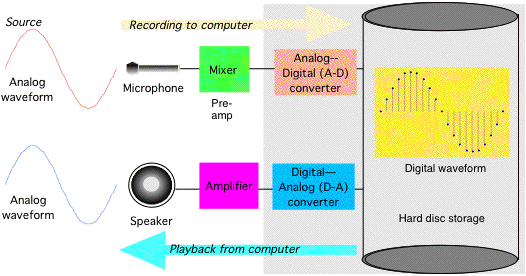
FIGURE 5.1. Chain of events in the recording and playback of desktop audio.
Microphone construction
For most purposes, a pressure transducer, or microphone, is the most important
device for recording sound sources. Two of the most common types are the
dynamic and condenser
microphones. Dynamic microphones function via the movement of a wire known
as a voice coil that is attached to the microphone
diaphragm; these are mounted near a magnet
(see Figure 5.2, left). Sound waves impinge upon the diaphragm, which
is flexible. This moves the voice coil back and forth with the magnetic
field, causing an electrical variation proportional to the incoming sound
wave.
A condenser (or electrostatic) microphone
works with an electrically-charged diaphragm located near a fixed, electrically-charged
surface called the back plate (see Figure
5.2, right). The diaphragm and back plate together form complimentary
parts of an electrical capacitor. Unlike a dynamic microphone, a voltage
supply must be supplied to the condenser microphone. On less expensive
microphones, such as the ones that come included with a portable video
camera, the voltage is supplied by a AA 1.5 volt battery inside the body
of the microphone itself. An external power supply is necessary with professional
microphones, which is provided from the mixing console or a specialized
microphone preamplifier. This microphone voltage is sometimes referred
to as phantom power since it can be delivered
via the microphone cable; voltages usually range from 12 to 48 volts.
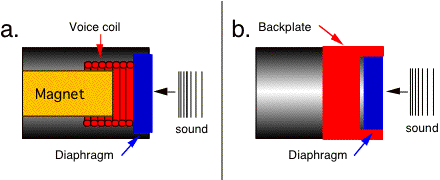
FIGURE 5.2. Cut-away view of dynamic (a.) and condenser (b.) microphones.
The choice between a condenser and a dynamic microphone depends upon
several factors. Generally, condenser microphones have a wider, more linear
frequency response than dynamic microphones, especially at high and low
frequencies. Another issue is that dynamic microphones are generally more
rugged than condenser microphones. This causes them to be the choice in
sound reinforcement applications; you can drop a dynamic microphone on
the floor and they still function nicely, whereas a condenser microphone
tends to be more delicate. Condenser microphones also tend to have more
features, such as a variable pick-up pattern, and filtering. Finally,
condenser microphones are more liable to distortion than are dynamic microphones.
For example, since percussion puts out very high dB SPL levels when played,
one almost always uses dynamic microphones on them.
Click here to listen to an example of
speech recorded with a dynamic microphone, and click here to listen to an example recorded with a condenser microphone.
Note that the condenser microphone has a fuller sound quality. The condenser
microphone in this example retails for around $1000.00 (Figure 5.3, right),
while the dynamic microphone retails for about $125.00 (Figure 5.3, left).
One would probably want as much high frequency as possible in a recording
of a cymbal, but perhaps not with a voice; sometimes the filtering of
high frequencies is heard as a “warm” sound. When you have
a choice, such as in a recording studio, one can tailor each microphone
to a particular recording technique in order to affect the tone color
and to avoid distortion. The difference between manufacturers, models,
and even the electronic circuitry within various microphones causes each
specimen of any kind of microphone to sound different, if even slightly.
Below, we go over the most common types of microphones, with particular
attention given to their directivity pattern
(or “pick-up pattern”). It is common practice to describe
a microphone primarily in terms of its directivity, and to identify it
as a condenser or dynamic microphone.
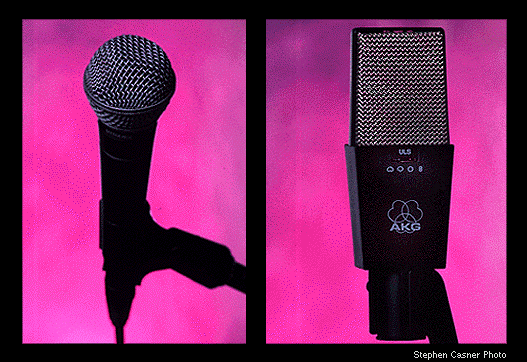
FIGURE 5.3. Dynamic (Sure SM-57) and condenser (right?KG 414-EB) microphones.
Microphone Directivity patterns
Two of the most common types of microphone directivity patterns in use
are omni-directional and cardiod
(see Figure 5.4). An omni-directional microphone picks up a sound source
equally from all directions, while a cardiod (sometimes called “unidirectional”)
microphone is most sensitive from the front, and is progressively less
sensitive towards the direction of the rear of the microphone diaphragm.
Figure 5.5 (left) shows a bi-directional
(sometimes called “figure-of-8”) microphone pattern. Usually,
the bi-directional pattern is a selectable feature of a microphone that
has the capacity for switching between several different patterns. This
type of microphone is equally sensitive from the front and rear, but attenuates
signal from the sides, making it very useful for specialized situations
such as micing a conversation between two people. It can also be used
to emphasize reverberation in a more specific manner than a omni-directional
microphone, as demonstrated in Figure 5.13, below.
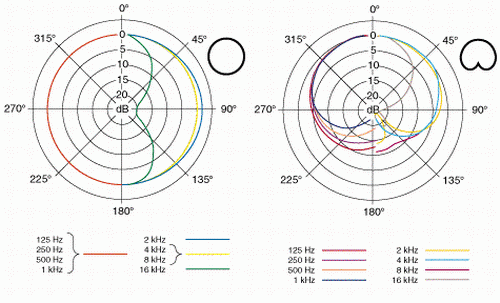
FIGURE 5.4. Omni-directional and cardiod micing patterns.
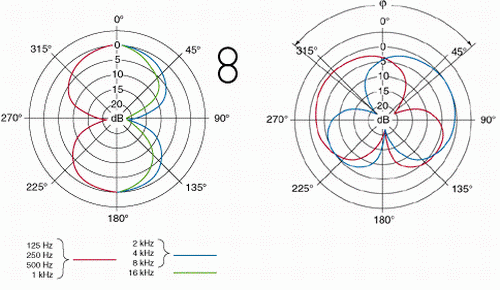
FIGURE 5.5. Bi-directional (left) and stereo (right) micing patterns.
Figure 5.5 (right, on previous page) shows a type of stereo microphone pattern. A stereo microphone contains two microphones in a single housing with two separate output lines. One line is usually sent to the left input and the other to the right input. These tend to be either relatively inexpensive or very expensive condenser microphones. The less expensive models are designed to be used for ensemble as opposed to spot micing, and have two cardiod-pattern microphones, sometimes with a range switch that moves the pickup pattern outwards from 90 to 120 degrees to allow capture of a wider range of sound sources. The more expensive, professional-level stereo microphones have variable patterns that can be adjusted electronically. Figure 5.6 shows a photograph of a medium-quality stereo condenser microphone.
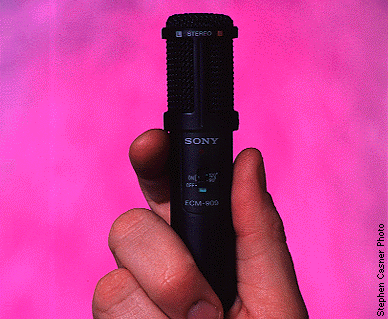
FIGURE 5.6. Stereo cardiod microphone with variable cardiod pattern.
Figure 5.7 below shows supercardiod and hypercardiod microphone directivity
patterns. The supercardiod pattern is often a selectable feature on more
expensive microphones, and allows a tighter focus at the sound from the
front compared to the sides. However, the response increases a bit from
the rear of the mic capsule. The hypercardiod pattern is narrower still,
and has a corresponding increase in sensitivity from the rear to the rear.
A shotgun microphone is used when one wants to aim the pickup pattern
of a signal as precisely as possible. The hypercardiod pickup pattern
requires a microphone construction that is long and narrow. However, contrary
to its portrayal in a certain movie released in the 1970s, the pickup
pattern is not so precise that one can aim it at a sound source to the
exclusion of all other sounds. In the film just mentioned, a sound efx
person aims the mic and is able to capture sounds of owls in trees, criminals,
etc., at hundreds of feet distance, with a resulting sound as if the sources
were close-miced. Shotgun microphones are used when you want an effect
similar to close micing but are required to maintain a distance from the
sound source, such as in some film and video shots.
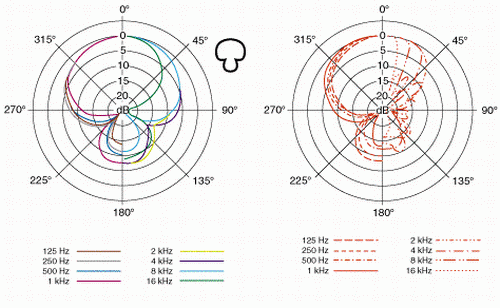
FIGURE 5.7. Hypercardiod (left) and supercardiod (right) mic patterns.
Other types of microphones; connections and cable
We’ve gone over the most common types of microphones, but there
are many other types with different methods of transduction, pick-up patterns
and sizes that are appropriate for various applications. One that is especially
useful is the miniature microphone, a small
microphone that can be attached directly to the clothing of a person or
to a sound source (some types are called lapel microphones
since they attach to the lapel of a coat). These small omni-directional
microphones can sound excellent when placed near the sound source, but
are generally too noisy to use for distant micing. Studying a good source
book on recording engineering techniques (see Chapter 7) and a catalogue
from a microphone manufacturer is the next best thing to actual “hands-on”
and “ears-on” experience.
Another issue is microphone impedance. Impedance
can be thought of as electrical resistance; with longer distances between
the microphone and the recording device, less resistance is desirable.
Professional microphones are generally low impedance, and use 3-pin XLR
connectors and shielded cable to provide
noise immunity; the cable can be detached from the microphone (see Figure
5.8). “Consumer” microphones use either 1/4 inch or miniature
phone jack connectors, and the cable is permanently attached to the microphone
(see Figure 5.9).
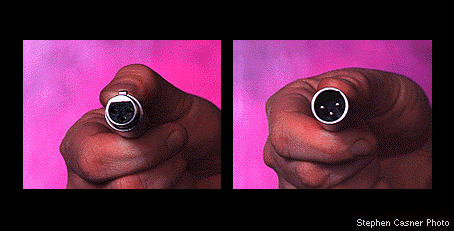
FIGURE 5.8. XLR connectors. These are typically used with low-impedance microphones and shielded cable.
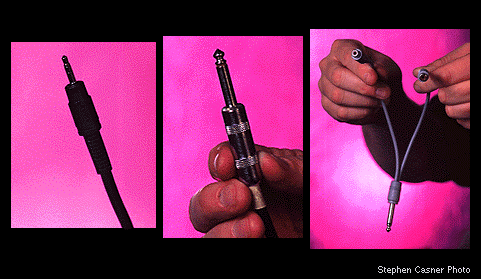
FIGURE 5.9. Connectors: stereo 1/8” miniature plug; 1/4” phone plug; “y” cable—2 RCA female connectors to a single 1/4” phone plug.
Microphone distance and reverberation
Three of the main considerations to micing distance is 1) desired pickup
pattern 2) inclusion or exclusion of reverberation, and 3) avoiding distortion.
The ideal distance to a sound source depends strongly upon both the environmental
and recording contexts. Spot micing refers
to the technique of isolating a particular instrument, voice or other
sound source with (usually) a single microphone placed relatively close
to the source. Often several spot microphones are used at once, such as
in sound reinforcement at a live concert, or in a recording studio. The
recording and live sound engineers require the signal from each instrument
to be as isolated as possible at the mixer, to enable independent adjustment
of the level of each instrument. This is illustrated in Figure 5.10. An
audio mixer is used to distribute each microphone input to left and right
outputs that create the illustrated spatial imagery for the headphone
listener.
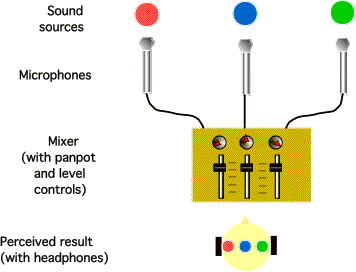
FIGURE 5.10 Close micing using cardiod-directivity microphones.
Distant micing refers to the technique of using one or more microphones to capture a group of sound sources and/or to capture the environmental context of a sound source. It is usually more difficult to accomplish good distant micing. Figures 5.11 and 5.12 show two different techniques. The first is referred to as “spaced omnis”, often a “hole in the center” of the speakers is perceived during stereo playback. The second is referred to as coincident pair micing. This technique is generally preferred, especially with classical music. One can also use a combination of microphones, but the chances of destructive phase interference as discussed in Chapter 3 become more relevant.
Note that in Figure 5.12 the image positions are reversed inside the head of the listener. This is because the left microphone is pointed at the right, and vice versa. The engineer could easily remedy this by switching the input cables to the mixer! But like photographs which are frequently reproduced with a ‘backwards negative,” stereo sound is often reproduced in reverse channel configuration, usually without negative effects. If a visual and auditory image were linked, this would naturally be a more noticeable problem.
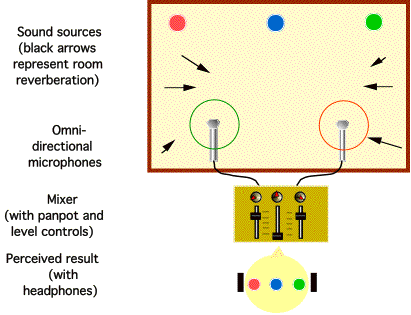
FIGURE 5.11. Distant micing technique using spaced omni-directional microphones.
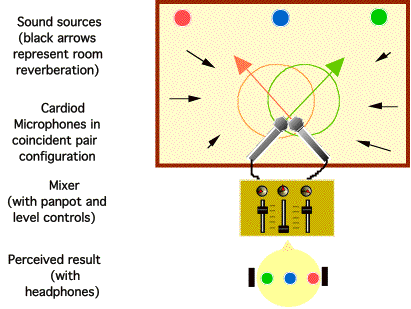
FIGURE 5.12. Distant micing technique using coincident pair (see text).
If there are undesirable sounds in the immediate vicinity, for instance
the sound of a camera crew during a live shooting, then spot micing is
always desirable. One of the first things that amateur recording artists
as well as amateur photographers find out is that what they record usually
has a lot more information in it than they desired, information that can
detract from the intended image. I can record a sound at a cafe of some
people talking next to me with the built-in microphone on my PowerBook,
but I'm also going to get the sound of the wind, the sound of other conversations,
the dishes clanking, and so on (for an example click here). Our hearing system allows us to focus in on a desired signal
more easily than a microphone, and since the recording system is both
less precise and removed in time from our current associations, context,
etc., the conversation becomes lost within the surrounding conversations.
The effect of reverberation within a room will indirectly affect the quality
of a recording, even with close micing. We can alter the amount of reverberation
either by moving the microphone or by changing its pick-up pattern. Figure
5.13 demonstrates this with a recording of a musical pattern played on
the tablas. Position 1 spot micing; an omni-directional position is used,
with the mic placed almost in-between the tablas. Position 2 uses four
different patterns at a distance of 3 feet; position 3 uses two different
patterns at 6 feet. Listen closely to the differences (headphones are
best), particularly to the differences in timbre and reverberation.
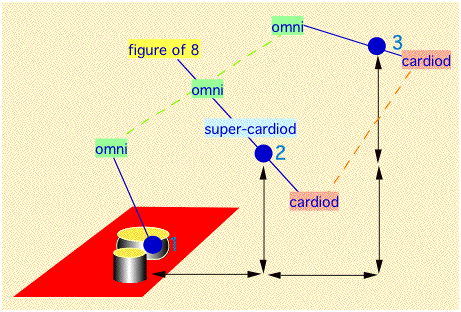
FIGURE 5.13. Tabla micing example (see text). Each black arrow corresponds to 3 feet distance. Push on text of microphone type to compare micing distance and directivity differences.
While micing at different distances can result in different reverberant-direct sound ratios, bringing microphones up very close to a sound source can emphasize low frequencies in the spectra, sometimes in a very unnatural way. This emphasis is known as the proximity effect, and is frequently exploited when recording narratives in order to give the spoken voice a deeper quality (click here to hear without proximity effect; click here to hear it).
Level Matching and Mixing
Besides microphones, one can also use electronic analog sound source—the
output of a mixing console, another tape recorder, guitar pickup, or synthesizer—as
sound cast members. In these cases there is a transference of electrical
voltage from one storage medium to another. In most cases the device in
question will have an output voltage level referred to as line
level. Microphones on the other hand have very small levels and
require pre-amplification so as to reach
line level. Most of the multimedia sound cards available work best when
supplied with a line level input at the A-D converter, since the quality
of a microphone preamplifier is a significant factor in the resulting
quality of the input signal.
In order to pre-amplify and attenuate various microphone and line-level
signals, a hardware, analog audio mixing console
(popularly termed a “mixer”)
is often the best choice. To the beginner, a mixer can look daunting with
its many knobs, sliders and switches. A mixer is often described in terms
of the number of inputs and outputs; e.g., an “8 in 2 out”
configuration is quite common. It is easier to think of it as altering
the audio signal flow from input to output much in the same way a plumbing
system routes water in a house to various faucets. The key to understanding
is in terms of the basic signal flow functions shared by all mixers. These
are input gain controls, panning and output assignment, effect
send and return, and output gain (or master
gain) controls.
Figure 5.14 graphs each of these functions within a hypothetical, 2 input,
2 output mixer. The input gain controls scale or amplify the input signals
in relation to one another. The signal is then passed the output buss
line; there is at least one buss line per output. If there are
two outputs (a “stereo mixer”) then the pan
control assign the relative proportion of signal that is passed
to each output buss line. The pan control is a simple way of controlling
the stereo image at the output; panning to the center sends an equal level
to both speakers, creating a “centered image;” images are
shifted to the left and right proportional to the pan pot setting. The
output of the mixer is a line level “mixture” of all of the
input signals at each buss, which can then be connected to the input of
a sound card on a computer, a tape recorder, or a sound reinforcement
system. The effects send and return is the way reverberation and other
effects from external devices are added to each input.
An analog audio mixer such as described here can be a useful device for
mixing signals as well as for providing pre-amplification for a microphone
signal. But in many cases it is more convenient to use software mixing
functions for desktop audio applications. These are described below in
Chapter 7.
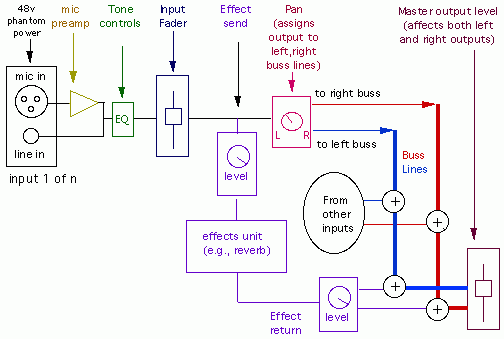
FIGURE 5.14. Functions of a basic mixer for desktop audio.